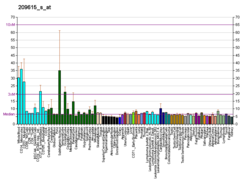Function
PAK proteins are critical effectors that link Rho GTPases to cytoskeleton reorganization and nuclear signaling. PAK proteins, a family of serine/threonine p21-activated kinases, include PAK1, PAK2, PAK3 and PAK4. These proteins serve as targets for the small GTP binding proteins Cdc42 and Rac and have been implicated in a wide range of biological activities. PAK1 regulates cell motility and morphology. Alternative transcripts of this gene have been found, but their full-length natures have not been determined. [14]
Stimulation of PAK1 activity is accompanied by a series of cellular processes that are fundamental to living systems. PAK1 is a nodular signaling molecule, and operates as a converging station of a large number of signals triggered by proteins on the cell surface as well as upstream activators.
At the biochemical level, these activities are regulated by the ability of PAK1 to phosphorylate its effector interacting substrates, which sets up a cascade of biochemical events culminating in a cellular phenotypic response. PAK1 action is also influenced by its scaffolding activity. Examples of PAK1-regulated cellular processes include actin and microtubule fiber movement, critical steps during cell cycle progression, cell motility and invasion, redox and energy metabolism, cell survival, angiogenesis, DNA repair, hormone sensitivity, and gene expression. PAK1 signaling is implicated in oncogenesis, [9] viral pathogenesis, [15] [16] cardiovascular dysregulation, [17] and neurological disorders. [18]
Activation/inhibition
The AID domain suppresses the catalytic activity of its kinase domain. PAK1 activators relieve this auto-inhibition and initiate conformational rearrangements and autophosphorylation events leading to kinase activation.
IPA-3 (1,1′-disulfanediyldinaphthalen-2-ol) is a small molecule allosteric inhibitor of PAK1. Preactivated PAK1 is resistant to IPA-3. Inhibition in live cells supports a critical role for PAK in PDGF-stimulated ERK activation. [19] Reversible covalent binding of IPA-3 to the PAK1 regulatory domain prevents GTPase docking and the subsequent switch to a catalytically active state. [20]
PAK1 knockdown in prostate cancer cells is associated with reduced motility, reduced MMP9 secretion and increased TGFβ expression, which in these cases, is growth inhibitory. However, IPA-3's pharmacokinetic properties as well as undesirable redox effects in cells, due to the continuous reduction of the sulfhydryl moiety, make it unsuitable for clinical development. [20]
Upstream activators
PAK1 activity is stimulated by a large number of upstream activators and signals, ranging from epidermal growth factor, [21] heregulin-beta 1, [22] Vascular endothelial growth factor, [23] basic fibroblast growth factor, [24] platelet-derived growth factor, [25] estrogen, [26] lysophosphatidic acid, [27] phosphoinositides, [28] Epithelial and Endothelial Tyrosine Kinase, [29] Protein kinase B, [30] JAK2, [31] Extracellular Signal-Regulated Kinase, [32] casein kinase II, [33] Rac3, [34] chemokine (C-X-C motif) ligand 1, [35] breast cancer anti-estrogen resistance 3, [36] Kaposi's sarcoma-associated herpesvirus-G protein-coupled receptor, [37] hepatitis B virus X protein, [38] STE20-related kinase adaptor protein α, [39] RhoI, [40] Klotho, [41] N-acetylglucosaminyl transferase V, [42] B-Raf proto-oncogene, [43] casein kinase 2-interacting protein 1, [44] and filamin A. [45]
Downstream effector targets
Functions of PAK1 are regulated by its ability to phosphorylate downstream effector substrates, scaffold activity, redistribution to distinct sub-cellular cellular sub-domains, stimulation or repression of expression of its genomic targets either directly or indirectly, or by all of these mechanisms. Representative PAK1 effector substrates in cancer cells include: Stathmin-S16, [46] Merlin-S518, [47] Vimentin-S25-S38-S50-S65-S72, [48] Histone H3-S10, [49] FilaminA-S2152, [45] Estrogen receptor-alpha-S305, [50] signal transducer and activator of transcription 5a-S779, [51] C-terminal binding protein 1-S158, [52] Raf1-S338, [53] Arpc1b-T21, [54] DLC1-S88, [55] phosphoglucomutase 1-T466, [56] SMART/HDAC1-associated repressor protein-S3486-T3568, [57] Tubulin Cofactor B-S65-S128, [58] Snail-S246 [59] vascular endothelial-cadherin-S665, [60] poly(RC) binding protein 1-T60-S246, [61] integrin-linked kinase 1-T173-S246, [62] epithelium-specific Ets transcription factor 1-S207, [63] ErbB3 binding protein 1-T261, [64] nuclear receptor-interacting factor 3-S28, [65] SRC3-delta4-T56-S659-676, [66] beta-catenin-S675, [67] BAD-S111, [68] BAD-S112, S136, [69] MEK1-S298, [70] [71] CRKII-S41, [72] MORC family CW-type zinc finger 2-S739, [73] [74] Paxillin-S258, [15] and Paxillin-S273. [75]
Genomic targets
PAK1 and/or PAK1-dependent signals modulate the expression of its genomic targets, [9] including, vascular endothelial growth factor, [23] Cyclin D1, [76] phosphofructokinase-muscle isoform, [77] nuclear factor of activated T-cell, [77] Cyclin B1, [78] Tissue Factor and tissue factor pathway inhibitor, [79] Metalloproteinase 9, [80] and fibronectin. [81]
This page is based on this
Wikipedia article Text is available under the
CC BY-SA 4.0 license; additional terms may apply.
Images, videos and audio are available under their respective licenses.











